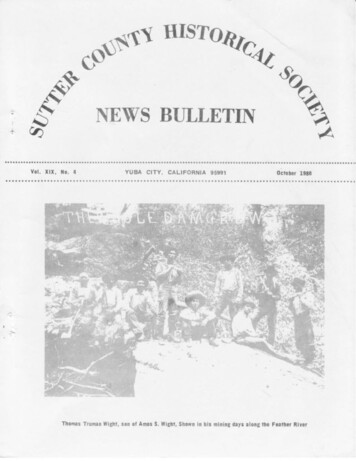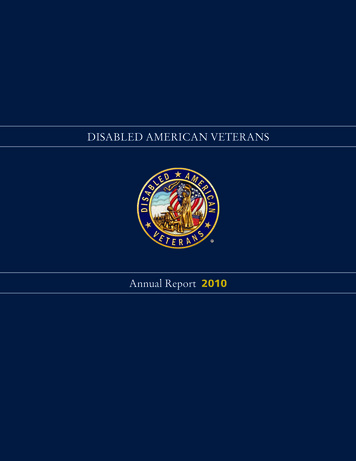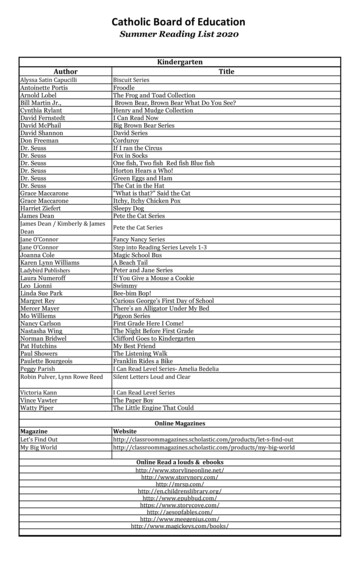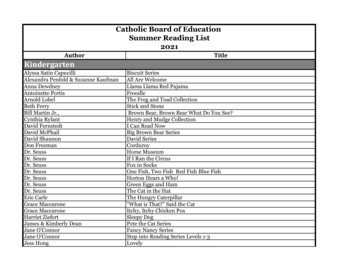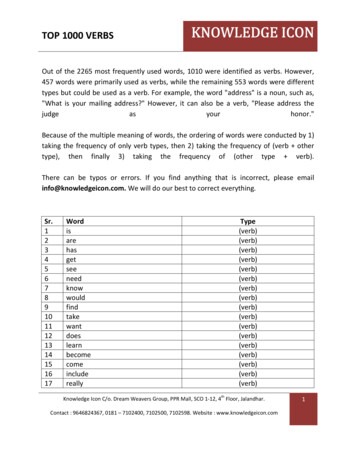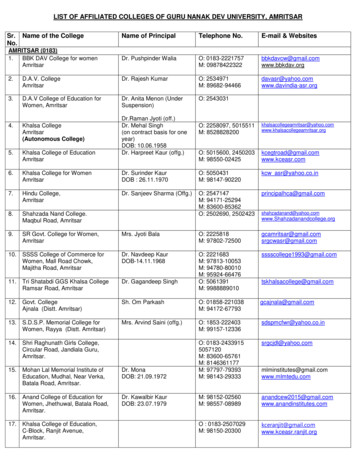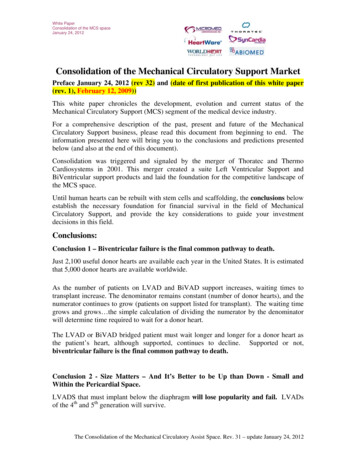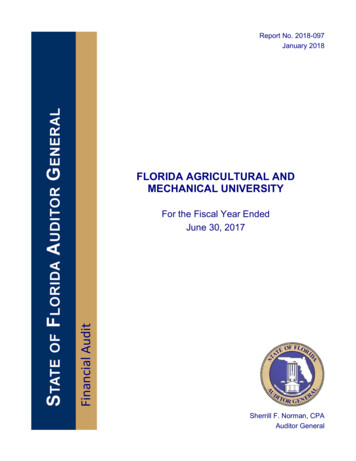
Transcription
DAV UNIVERSITY, JALANDHARDAV UNIVERSITY JALANDHARCourse Scheme & SyllabusForMaster of Technology in Computer ScienceEngineeringExaminations2016–2017 SessionSyllabi Applicable For Admissions in 2016Page 1 of 62
DAV UNIVERSITY, JALANDHARSession 2016–2017M Tech (Computer Science eCodeCSE613Course TitleLTPCrNature of CourseResearch MethodologyNumerical AnalysisAdvance Computer Networks &SimulationData Mining & WarehousingParallel Computing &ArchitectureAdvance Computer Networks n- LabData Mining & Warehousing-Lab00003322Core (Lab)Core (Lab)200624Course TitleLTPCrNature of CourseDigital Image ProcessingDiscipline Specific Elective -1Discipline Specific Elective -2Discipline Specific Elective -3Generic Elective-1Digital Image Processing LabDiscipline Specific Elective -2 1DSE-2DSE-3GE-1Core (Lab)DSE-2-LabSeminar180722Course TitleLTPCrNature of CourseDiscipline Specific Elective -4Generic Elective -2Dissertation Part – 1440000000448DSE-4GE-2Dissertation Part - 180016CourseCodeCourse TitleLTPCrNature of CourseCSE600ADissertation Part - 20000001212Dissertation Part - 2Page 2 of 62
DAV UNIVERSITY, JALANDHARDiscipline Specific ormation Security and riskmanagementSoftware Metrics and QualityEngineeringDistributed DatabasesCSE554Artificial IntelligenceCourseCodeCourse TitleWireless Data NetworksCSE534Agile Software tributed Computing SystemsCSE528Advanced Data Structure &AlgorithmsCourseCodeCSE524ACourse TitleWireless Data Networks LabCSE542Agile Software Development LabCSE538Bioinformatics 44004400440044004LTPCr.00002211002100210021Pattern Recognition & AnalysisCSE552CSE506BDSE-2LabCourse TitleDistributed Computing SystemslabAdvanced Data Structure &Algorithms LabPage 3 of 62Area ofSpecializationNetwork &SecuritySoftware Engg.ComputerVision & ImageprocessingDistributedComputingAlgorithms andAIArea ofSpecializationNetwork &SecuritySoftware Engg.ComputerVision & ImageprocessingDistributedComputingAlgorithms andAIArea ofSpecializationNetwork &SecuritySoftware Engg.ComputerVision & ImageprocessingDistributedComputingAlgorithms andAI
DAV UNIVERSITY, JALANDHARDSE-3CourseCodeCourse TitleLPCr.Area ofSpecializationCSE520Network Security4004Network &SecurityCSE542Unified Software ConfigurationManagement4004Software Engg.CSE544Machine Learning4ComputerVision & Imageprocessing4DSE-4TCSE546Cloud ComputingCSE550Natural language and ProcessingCourseCodeCourse Title004004DistributedComputing4004Algorithms andAILTPCr.Area ofSpecializationCSE621Network Intrusion Detection4004Network &SecurityCSE603Software Project Management4004Software Engg.CSE617Medical Image Analysis &VisualizationCSE619CSE6014004ComputerVision & ImageprocessingGrid Computing4004DistributedComputingEvolutionary Methods4004Algorithms andAIL: Lectures T: Tutorial P: Practical Cr: CreditsPage 4 of 62
DAV UNIVERSITY, JALANDHARGeneric ElectivesS. NoCourseCourse TitleLTPCr.Code1CSE901Soft Computing40042CSE902Mobile Communications4004L: Lectures T: TutorialP: PracticalCr: CreditsPage 5 of 62
DAV UNIVERSITY, JALANDHARDetailedSyllabusPage 6 of 62
DAV UNIVERSITY, JALANDHARCourse Title: Research MethodologyCourse Code: MGT551LT P Credits4 004Course Objective: The course is designed to introduce the students to researchmethodology and application of research techniques and procedures. The primary goal ofthis course is to develop a sound understanding of research methods.Learning Outcomes: The students will be able to apply the various research methods byusing computerized data analysis software’s to solve the real life problems.UNIT – AIntroduction to Research: Meaning of Research, Objectives of Research, Types ofResearch, Research Approaches, Significance of Research, Research Process, Criteria ofGood Research, Problems Encountered by Researchers in India.Defining the Research Problem: What is a Research Problem?, Selecting the Problem,Necessity of Defining the Problem, Technique Involved in Defining a ProblemResearch Design: Meaning of Research Design, Need for Research Design, Features of aGood Design, Important Concepts Relating to Research Design, Different Research Designs,Basic Principles of Experimental Designs, factors affecting RDs, Relation among RDs,Developing a Research Plan.UNIT – BSampling design and Procedures: Sample or Census, The Sampling Design Process, AClassification of Sampling Techniques, Choosing Nonprobability Versus ProbabilitySampling, Uses of Non probability Versus Probability Sampling.Measurement and Scaling: Non-comparative Scaling Techniques, Continuous RatingScale, Itemized Rating Scale, Non-comparative Itemized Rating Scale Decisions, Multi-itemScales, Scale Evaluation, Choosing a Scaling Technique.Methods of Data Collection: Collection of Primary Data, Observation Method, InterviewMethod, Collection of Data through Questionnaires, Collection of Data through Schedules,Some Other Methods of Data Collection, Collection of Secondary Data, Selection ofAppropriate Method for Data Collection.Questionnaire & form design: questionnaire & observation forms, questionnaire designprocess.UNIT – CData preparation: editing, coding, transcribingData analysis: tests of significance based on t, f and z distribution and chi-square test;cross tabulationMultiple Regression: Overview of Multiple Regression, Statistics Associated withMultiple Regression, Conducting Multiple Regression, Stepwise Regression,Multicollinearity Discriminant Analysis: Discriminant Analysis Model, StatisticsAssociated with Discriminant Analysis, Conducting Discriminant AnalysisConjoint Analysis: Basic Concepts in Conjoint Analysis, Statistics Associated withConjoint Analysis, Conducting Conjoint Analysis, Assumptions & Limitations of ConjointAnalysis, Hybrid Conjoint AnalysisPage 7 of 62
DAV UNIVERSITY, JALANDHARUNIT – DMulti-Dimensional Scaling: Basic Concepts in Multidimensional Scaling (MDS), StatisticsAssociated with MDS, Conducting Multidimensional Scaling, Selecting an MDS Procedure,Deciding on the Number of Dimensions, Labelling the Dimensions & Interpreting theConfiguration, Assessing Reliability and Validity, Assumptions & Limitations of MDS,Scaling Preference DataCorrespondence Analysis: Relationship between MDS, FA, & DAFactor Analysis: Factor Analysis Model, Statistics Associated with Factor Analysis,Conducting Factor Analysis, Applications of Common Factor AnalysisCluster Analysis: Statistics Associated with Cluster Analysis, Conducting Cluster Analysis,and Applications of Non-hierarchical Clustering, Clustering Variables.Research Report Writing: Contents of Report, Executive Summary, Bibliography format.Presentation of Report.REFERENCES:1. Bajpai Naval, Business Research Methods, Pearson Publications.2. Malhotra, Naresh K. Marketing Research: An Applied Orientation, 5th Edition.Pearson/Prentice-Hall, 2007.3. Proctor Tony, Essentials of Marketing Research, Prentice Hall, 4th Edition.4. Beri, G. C. Marketing research, McGraw-Hill, 4th Edition5. Kothari, C.R. Research Methodology, New Age Publishers.Page 8 of 62
DAV UNIVERSITY, JALANDHARLT P Credits4 0Course Title: Numerical AnalysisCourse Code: MTH551A04Objective:The aim of this course is to teach the applications of various numerical techniques for avariety of problems occurring in daily life. At the end of the course, the students will beable to do programming in MATLAB and understand the basic concepts in NumericalAnalysis of differential equations.UNIT-AApproximate numbers, Significant figures, rounding off numbers, Error Absolute, Relativeand percentageAlgebraic and transcendental equations: Review of some concepts, Solution ofalgebraic and transcendental equations: Bisection method, RegulaFalsi, Newton Raphson,Lin Barstow’s, convergence.Systems of simultaneous Equations: Crammer's rule, Gauss elimination, Gauss Jordonmethod, Matrix inversion method, Iterative methods: Jacobi method and Gauss-Seidelmethod, partition method, Eigenvalues and Eigen vectors: Cayley Hamilton theorem,Power method for finding largest Eigen value.UNIT –BFinite Difference Methods: Forward, Backward, Central differences, Newton’s forward,backward and divided difference formulae, Gauss, Stirling, Bessel central differenceformulae.UNIT –CNumerical Differentiation and Numerical Integration: Numerical Differentiation,Trapezoidal and Simpson’s one third, Simpson’s three eight rule for numerical integration,adaptive integration, Taylor’s series method, Euler, modified Euler method, Runge-Kuttamethods, Boole, weddle rule, Double integration.UNIT –DOrdinary and Partial Differential Equations: Solution of second and higher orderdifferential equations, boundary value problems, Solution of partial differential equations:Laplace, Heat, Wave equation.REFERENCES:1. Atkinson, K.E. An Introduction to Numerical Analysis, Wiley, 1989.2. Eriksson, K., Estep, D., Hansbo P. and Johnson, C. Computational Differential Equations,Cambridge Univ. Press, Cambridge, 1996.3. Golub, G.H. and Ortega, J.M. Scientific Computing and Differential Equations: AnIntroduction to Numerical Methods, Academic Press, 1992.4. Conte S.D. and Carl De Boor, Elementary Numerical Analysis, An Algorithmic Approach,Tata McGraw Hill, New Delhi, 1981.5. Jain, M.K. Numerical Analysis for Scientists and Engineers, S.B.W. Publishers, Delhi,1971.Page 9 of 62
DAV UNIVERSITY, JALANDHARCourse Tile: Advanced Computer Networks and SimulationCourse Code: CSE501LT P Credits4004PART-AIntroduction: Review of Computer Networks and the Internet: What is the Internet, TheNetwork edge, The Network core, Access Networks and Physical media, ISPs and InternetBackbones, Delay and Loss in Packet-Switched Networks, History of ComputerNetworking and the Internet - Foundation of Networking Protocols: 5-layer TCP/IP Model,7-Layer OSINetworking Devices: Multiplexers, Modems and Internet Access Devices, Switching andRouting Devices, Router Structure. The Link Layer and Local Area Networks: Link Layer:Introduction and Services, Error- Detection and Error-Correction techniques, MultipleAccess Protocols, Interconnections: Hubs and Switches.14 hoursPART-BATM: Asynchronous Transfer Mode Switching (ATM): Overview of ATM: - Introduction,What is ATM, Genesis of ATM, Basic Principles of ATM, ATM Standards, ATM ProtocolStack: Physical Layer, ATM Layer and AAL LayerTraffic Management in ATM-Traffic Contracting, Traffic Shaping, Traffic Policing,Priority Control, Flow Control, ATM Traffic Descriptors, ATM Service Descriptors (QoSParameters), ATM Signalling and its Protocol, ATM Addressing & Routing, ATMNetworking Standard.14 HoursPART-CTransport and End-to-End Protocols: Transport Layer, Transmission Control Protocol(TCP), User Datagram Protocol (UDP), IPv6 packet format-transition from IPv4 to IPv6Mobile IP, TCP Congestion Control Application Layer: Principles of Network Applications,The Web and HTTP, File Transfer: FTP, Electronic Mail in the Internet, Domain NameSystem (DNS), P2P File Sharing, Building a Simple Web ServerMedium Access Control (MAC) Techniques-goals and requirements of Medium AccessControl (MAC) techniques, Classify various contention based techniques such as ALHOA,CSMA, CSMA/CD and CSMA/CA.14 hoursPART-DMobile Communication: GSM (Global system for mobile communication)-Services andArchitecture, GPRS (General Packet Radio Service)-reference model, DECT (DigitalEnhanced Cordless Telecommunications), CDMA (Code Division Multiple access)Mobile A-Hoc Networks: Overview of Wireless Ad-Hoc Networks, Routing in Ad-HocNetworks, Routing Protocols for Ad-Hoc Networks – Wireless Sensor Networks: SensorNetworks and Protocol Structures, Communication Energy Model, Clustering Protocols,Routing Protocols.Networking Simulation Tools- OPNET, Ns 2, QualNet.Page 10 of 62
DAV UNIVERSITY, JALANDHAR14 hoursREFERENCES:1. Data Communications and Networking, Behrouz A. Forouzan, Fourth Edition, TataMcGraw Hill, 20072. Guide to Networking Essentials, Greg Tomsho,Ed Tittel, David Johnson,FifthEdition, Thomson3. An Engineering Approach to Computer Networking, S.Keshav, Pearson Education.4. Campus Network Design Fundamentals, Diane Teare, Catherine Paquet, PearsonEducation.(CISCOPress)5. Computer Networks, Andrew S. Tanenbaum, Fourth Edition, Prentice Hall.6. The Internet and Its Protocols,A.Farrel,Elsevier.Page 11 of 62
DAV UNIVERSITY, JALANDHARCourse Title: Data Mining & WarehousingCourse Code: CSE503L4T P Credits0 04Course Objective: This course will be an introduction to data mining and warehousing.Topics will range from statistics to database, with a focus on analysis of large data sets.Another objective is to study the methodology of engineering legacy databases for datawarehousing and data mining to derive business rules for decision support systems.Learning Outcomes: Upon completion of the course, students will be able to: Understand the nature and purpose of data warehousing Describe the theoretical constructs and core processes of data warehousing Understand the role of data mining and warehousing in institutional research. Understand the basic statistical concepts related to data mining warehousing Describe the predictive modelling functions of data mining and warehousing Describe the potential applications of data mining in higher education i.e., decisionsupport, assessment, accountability, resource allocation, enrolment management, andquality improvement initiatives. Use a data mining program to analyse sample data and develop predictive models. Be able to compare and evaluate the accuracy of predictive models based onclassification and clustering.PART-AData mining: Overview, Definition & FunctionalitiesData Processing: Form of Data Pre-processing, Data Cleaning: Missing Values, Noisy Data,(Binning Clustering, Regression, Computer and Human inspection), Inconsistent Data,Data Integration and Transformation. Data Reduction: Data Cube Aggregation,Dimensionality reduction, Data Compression, Numerosity, Reduction, Clustering,Discretization and Concept hierarchy generation14 HoursPART-BConcept Description: Definition, Data Generalization, Analytical Characterization,Analysis of attribute relevance, Mining Class comparisons, Statistical measures in largeDatabases. Measuring Central Tendency, Measuring Dispersion of Data, Graph Displays ofBasic Statistical class Description, Mining Association Rules in Large Databases.Association rule mining: mining Single-Dimensional Boolean Association rules fromTransactional Databases– Apriori Algorithm Mining Multilevel Association rules fromTransaction Databases Mining Multi-Dimensional Association rules from RelationalDatabases14 hoursPART-CClassification and Predictions: What is Classification & Prediction, Issues regardingClassification and prediction, Decision tree, Bayesian Classification, Classification by Backpropagation, Multilayer feed-forward Neural Network, Back propagation Algorithm,Classification methods K-nearest neighbour classifiers, Genetic Algorithm.Page 12 of 62
DAV UNIVERSITY, JALANDHARCluster Analysis: Data types in cluster analysis, Categories of clustering methods:Partitioning methods. Hierarchical Clustering-CURE and Chameleon, Density BasedMethods-DBSCAN, OPTICS, Grid Based Methods-STING, CLIQUE, Model Based Method –Statistical Approach, Neural Network approach, Outlier Analysis14 hoursPART-DMining Complex Types of Data: Multidimensional analysis & Descriptive mining ofComplex data objects, Mining Spatial Databases, Mining Multimedia Databases, MiningTime-series & Sequence data, Mining Text databases, Mining World -Wide WebData Mining Applications and Trends in Data Mining: Massive Datasets/Text mining,Agent Based Mining14 hoursREFERENCES:1.2.3.4.M.H.Dunham, Data Mining: Introductory and Advanced Topics, Pearson EducationJiawei Han, Micheline Kamber, Data Mining Concepts & Techniques, ElsevieC. M. Bishop, Pattern Recognition and Machine Learning, SpringerS. Theodoridis and K. Koutroumbas, Pattern Recognition, 4th Edition, AcademicPress, 2009.5. Arun k. Pujari, Data Mining Techniques, Universities Press Private Limited.Page 13 of 62
DAV UNIVERSITY, JALANDHARCourse Title: Parallel Computing & ArchitecturePaper Code: CSE505L4T P Credits0 04Course Objective: Students will learn about programming paradigms used in parallelcomputation, about the organization of parallel systems.Learning Outcomes: After the completion of this course the participants would gain theknowledge of parallel organization of computers, their working and different componentsPART-AParallel Computer Introduction: Basic issues and models, Computational speed laws,Computer Structures: Types of parallel computers: Parallel Processors, Array Computers,Multiprocessors, shared and distributed memory machines: MIMD, networked computersas a multi complier platform, symmetric multiprocessing.Hardware Organization: Flynn's Classifications: SISD, SIMD, MISD, MIMD, Handler'sclassifications14 HoursPART-BSoftware Organization: Kung's Classification, SPMD: Single Program Multiple DataParallel Computational Models: Combinational Circuits, PRAM Models: ConstrainedPRAM Models, PRAM-CREW, EREW models, Handling Shared Memory Access Conflicts,Parallelism, Goals of parallelism, Parallelism and concurrency, Parallelism approaches:Data Parallelism, Control Parallelism.14 HoursPART-CPerformance of Parallel Systems: Performance matrices for Parallel systems: Run time,Speed up, Efficiency and Cost, Laws governing performance measurements, LoadBalancing: Fully Distributed, Semi distributed and centralized distributed, Bench Marks:Wet Stone, Dry Stone.Programming of Parallel Computers: Shared Memory Programming, DistributedMemory Programming, Object Oriented Programming, Data Parallel Programming,Functional and Dataflow Programming14 HoursPART-DParallel Architecture: Taxonomy of parallel structures, Control mechanism, AddressSpace Organization, Interconnection connection networks: Static and Dynamicinterconnection networks, evaluating static interconnection networks, embedding othernetworks (Linear Array, Mesh, Binary Tree) into a hypercube; Routing mechanisms forstatic interconnection networks: Store and Forward (SF) Routing; Cut - Theory (CT)Routing; Cost-Performance trade-off; Architectural Models for Parallel Algorithm design.Scheduling and Parallelization: Scheduling Parallel Programs, Loop scheduling,Parallelization of sequential programs.14 HoursPage 14 of 62
DAV UNIVERSITY, JALANDHARREFERENCES:1. Kai, Hwang, “Computer Architecture and parallel processing”, Tata McGraw Hill Co.2. Vipin Kumar, Ananth Grama, Anshul Gupta and George Karypis “Introductionto Parallel Computing”, Addison Wesley (2003) 2nd edition.3. Barrey Wilkinson, Michael Allen “Parallel Programming” Pearson Education.4. Hwang & Briggs F.A., “Computer Architecture and Parallel Processing “TataMcGraw Hill Co.5. Michael J. Quinn, Parallel Computing: Theory and Practice, Tata McGraw-Hill, 4thEdition, ISBN: 9780070512948, 2004.6. Albert YH Zomaya, Parallel and distributed computing handbook, McGraw-Hill, Inc.Page 15 of 62
DAV UNIVERSITY, JALANDHARCourse Title: Advance Computer Networks and Simulation LabCourse Code: CSE507L T P0 03Cr2List of Experiments:1. Introduction to Network Simulator OPNET/NS2.2. Simulation of Wireless data Network with different with physical characteristics.3. Comparative investigation on Hub and Switch as Interconnecting Device forverifying performance of LAN with various applications.4. To plan and analyze the Wireless Local Area Network using OPNET.5. Simulation of Ad-hoc based WLAN.6. Simulation of Cluster Topology.7. Rapid Configuration of Wired Network (Token Ring Topology).8. Implementation of CSMA/CD Protocol and its comparative investigation withALOHA Protocol.9. Implementation of CSMA/CD Protocol and its comparative investigation withALOHA Protocol.10. Design a Project having two scenarios: (a) Star Topology Wireless Network usingrapid configuration method. (b) Ring Topology Wireless network also using rapidconfiguration method, Compare the performance parameters like: End to EndDelay for data, Traffic Received, Queue size etc.11. Design Wireless network using Carrier Sensing Multiple Access Technique, Checkthe performance parameters like: Channel Throughput, Signal to Noise Ratio etc.12. Designs a Star shaped Wireless topology and suggest a suitable way to importtraffic.* Students are advised to use OPNET/NS2 for above listed experiments.This is only the suggested list of Practicals. Instructor may frame additional Practicalsrelevant to the course contents.Page 16 of 62
DAV UNIVERSITY, JALANDHARCourse Title: Data Mining and Warehousing Lab.Course Code: CSE509LT P Credits0032Students are required to perform practical in Oracle/MS SQL Server and STATISTICA DataMinerList of Experiments:1. Building a Database Design using ER Modelling and Normalization Techniques2. Implementation of functions, Procedures, Triggers and Cursors3. Load Data from heterogeneous sources including text files into a predefinedwarehouse schema.4. Design a data mart for a bank to store the credit history of customers in a bank .Usethis credit profiling to process future loan applications.5. Feature Selection and Variable Filtering (for very large data sets)6. Association mining in large data sets7. Interactive Drill-Down, Roll up, Slice and Dice operations8. Generalized EM & k-Means Cluster Analysis9. Generalized Additive Models (GAM)10. General Classification and Regression Trees (GTrees)11. General CHAID (Chi-square Automatic Interaction Detection) Models12. Interactive Classification and Regression TreesPage 17 of 62
DAV UNIVERSITY, JALANDHARCourse Title: Digital Image ProcessingCourse Code: CSE502AL T P3 00Credits3Course Objective: This course provides an introduction to basic concepts, methodologiesand algorithms of digital image processing focusing on the following two major problemsconcerned with digital images: (1) image enhancement and restoration for easierinterpretation of images, and (2) image analysis and object recognition. Some advancedimage processing techniques (e.g., wavelet and multi resolution processing) will also bestudied in this course. The primary goal of this course is to lay a solid foundation forstudents to study advanced image analysis topics such as computer vision systems,biomedical image analysis, and multimedia processing & retrieval.Learning Outcomes: To understand (i.e., be able to describe, analyse and reason about)how digital images are represented, manipulated, encoded and processed, with emphasison algorithm design, implementation and performance evaluation.PART-ADigital Image Fundamentals: Why is Computer Vision Difficult? Different stages of imageprocessing and analysis, Components of image processing system, Sampling andQuantization, Some basic relationships like neighbour’s connectivity, distance measurebetween pixels.Image Enhancement and Restoration: Basic Intensity Transformation Functions,Histogram processing, Spatial Domain methods: Fundamentals of spatial filtering,Smoothing Spatial Filters, Sharpening Spatial Filters, Frequency domain methods: lowpass filtering, high pass filtering, Image Degradation/Restoration modelPART-BImage Compression: Fundamentals of image compression, error criterion, Coding Interpixel and Psycho visual redundancy, Image Compression models, Error free compression:Huffman, Arithmetic, Run length Coding, Lossy Compression: Block Transform Codingbased on DCT and DWT.Morphological image processing: Basic Morphology concepts, Binary dilation anderosion, Opening and Closing operations, Basic Morphological Algorithms: Boundaryextraction, Hole Filling, Extraction of Connected Components.Color image processing Color Image-Processing Fundamentals, RGB Models, HSI Models,and Relationship between Different Models.PART-CImage Segmentation and Edge Detection: Fundamentals, Point, Line and EdgeDetection: Detection of isolated points, lines, Basic Edge Detection, Advanced Edgedetection using canny edge detector, Laplacian edge detector and Laplacian of Gaussianedge detector. Edge Linking and Boundary Detection, Thresholding: Basic GlobalThresholding and Optimum Global Thresholding using Otsu’s Method, Region BasedSegmentation: Region Growing, Region Splitting and Merging.Representation and Description: Representation schemes like chain coding, Polygonalapproximation using minimum perimeter polygon, Signatures, Boundary Descriptors:Page 18 of 62
DAV UNIVERSITY, JALANDHARShape Numbers, Fourier, and Statistical moments. Regional Descriptors: TopologicalDescriptors, Texture, Moment InvariantsPART-DRecognition and Interpretation: Pattern and pattern classes, Decision Theoreticmethods: minimum distance classifier, matching by correlation, Structural Methods:Matching Shape NumbersApplications of Image Processing: Study and Analysis of applications of Imageprocessing in different fields i.e. Information Security, Bioinformatics, Medical Science etc.Develop one application using a standard tool.REFRENCES:1. Digital Image Processing By Rafael C.Gonzales, Richard E. Woods, PearsonEducation.2. Digital Image Processing and Computer Vision by Sonka, Hlavac, Boyle CengageLearning3. Fundamentals of Digital Image Processing By Jain, Pearson Education4. Digital Image Processing and Analysis by Chanda & Majmuder, PHI5. Digital Image Processing by W. K. Pratt, John Wiley6. Pattern Classification, Duda, R.D. and Hart, P.E., Stork, D. G.Page 19 of 62
DAV UNIVERSITY, JALANDHARCourse Title: Digital Image Processing LabCourse Code: CSE540LTP002Students are required to perform practical is MATLAB 7.0 or higher versionList of Experiments:Lab 1: Write a program for image enhancementLab2: Write a program for image compressionLab3: Write a program for color image processingLab4: Write a program for image segmentationLab 5: Write a program for image morphologyLab 6: Write a program for Image RestorationLab 7: Write a program for Edge detectionLab 8: Write a program for Blurring 8 bit color versus monochromePage 20 of 62Credits1
DAV UNIVERSITY, JALANDHARDisciplineSpecificElectivesPage 21 of 62
DAV UNIVERSITY, JALANDHARCourse Title: Information Security & Risk ManagementCourse Code: CSE508LTP400Credits4Course Objective: The aim of this course is to provide attendees with a thoroughunderstanding of the issues associated with the design, provision and management ofsecurity services for modern communication and information systems. Students will learnthe different aspects of information and network security and you will be able to speakabout a multitude of security attacks and the defensive strategies used to combat them.Learning Outcomes: After completing this course the student should be able to: Describethe fundamental concepts of information system security. Understand the followingterms: security policy, host based security, firewall, and packet filtering and intrusiondetection. Use various software tools to analyze network and host vulnerabilities.PART-AOverview: Services, Mechanisms, and Attacks, the OSI Security Architecture, a Modelfor Network Security.Classical Encryption Techniques: Symmetric Cipher Model, Substitution Techniques,Transposition Techniques, Rotor Machines, Steganography.Block Ciphers And The Data Encryption Standard: Simplified DES, Block CipherPrinciples, The Data Encryption Standard, The Strength of DES, Differential and LinearCryptanalysis, Block Cipher Design Principles, Block Cipher Modes of Operation.Introduction To Finite Fields: Groups, Rings, and Fields, Modular Arithmetic, Euclid’sAlgorithm, Finite Fields of the Form GF(p), Polynomial Arithmetic, Finite Fields of theForm GF(2n).14 hoursPART-BAdvanced Encryption Standard: Evaluation Criteria for AES, The AES Cipher.Contemporary Symmetric Ciphers: Triple DES, Blowfish, RC5, Characteristics ofAdvanced Symmetric Block Ciphers, RC4 Stream Cipher.Confidentiality Using Symmetric Encryption: Placement of Encryption Function, TrafficConfidentiality, Key Distribution, Random Number Generation.Public-Key Encryption and Hash Functions: Introduction to Number Theory: PrimeNumbers, Format’s and Euler's Theorems, Testing for Primality, The Chinese RemainderTheorem, Discrete Logarithms.Public-Key Cryptography and RSA: Principles of Public-Key Cryptosystems, the RSAAlgorithm, Recommended Reading and Web Site, Key Terms, Review Questions, andProblems.Key Management and Other Public-Key Cryptosystems: Key Management, DiffieHellman Key Exchange, Elliptic Curve Arithmetic, Elliptic Curve Cryptography.14 hoursPART-CPage 22 of 62
DAV UNIVERSITY, JALANDHARMessage Authentication and Hash Functions: Authentication Requirements,Authentication Functions, Message Authentication Codes, Hash Functions, Security ofHash Functions and MACs.Hash Algorithms: MD5 Message Digest Algorithm, Secure Hash Algorithm, RIPEMD-160,and HMAC.Digital Signatures and Authentication Protocols: Digital Signatures, AuthenticationProtocols, Digital Signature Standard.14 hoursPART-DNetwork Security Practice: Authentication Applications: Kerberos, X.509 AuthenticationService, Electronic Mail Security: Pretty Good Privacy, S/MIME.IP Security: IP Security Overview, IP Security Architecture, Authentication Header,Encapsulating Security Payload, Combining Security Associations, Key Management, WebSecurity: Web Security Considerations, Secure Sockets Layer and Transport LayerSecurity, Secure Electronic Transaction.System Security: Intruders: Intruders, Intrusion Detection, Password Management,Malicious Software: Viruses and Related Threats, Virus Countermeasures, Firewalls:Firewall Design Principles, Trusted Systems.14 hoursREFERENCES:1
Unified Software Configuration Management 40 Software Engg. Computer CSE544 Machine Learning Vision & Image . (MDS), Statistics Associated with MDS, Conducting Multidimensional Scaling, Selecting an MDS Procedure, . GPRS (General Packet Radio Service)-reference model, DECT (Digital Enhanced Cordless Telecommunications), CDMA (Code Division .


